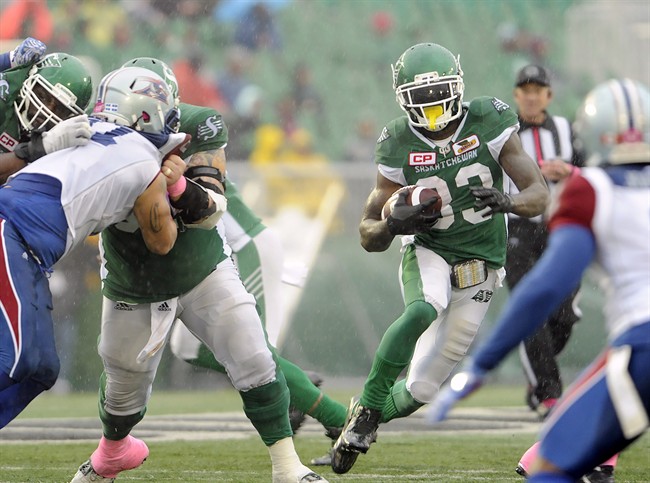Jurors heard attorneys’ final arguments Friday in the trial of the man who killed former NFL running back Joe McKnight, with prosecutors insisting it was an act of road-rage-related murder and defence attorneys saying the killer feared he was in danger from the hulking pro athlete.

Ronald Gasser, 56, is charged with second-degree murder in McKnight’s December 2016 death. Police said it happened at the end of a five-mile rolling confrontation that began with dangerously aggressive driving on a New Orleans bridge and ended with McKnight being shot as he stood outside Gasser’s car at a suburban intersection.
If convicted as charged by the jury that was set to begin deliberations Friday afternoon, he would face a mandatory life sentence.
READ MORE: Defence, prosecution spar as Joe McKnight slaying trial opens
Prosecutors didn’t deny that McKnight drove dangerously before he was killed. “We do not dispute that he was driving like a jerk,” Assistant District Attorney Seth Shute said, alluding to witness testimony that McKnight weaved in and out of traffic, cutting Gasser and others off, at high speed.
But Shute said Gasser escalated the danger, taking McKnight’s driving as a challenge. “Mr. Gasser thought that Mr. McKnight had thrown the gauntlet down,” Shute told jurors, later adding, “He followed him off the exit. That was not his exit.”
Shute acknowledged that McKnight had a hand on the open, passenger side window of Gasser’s car before he was shot. But he said physical evidence proved Gasser lied during extensive police questioning when he claimed McKnight lunged at him. He cited the lack of gun powder on McKnight’s body as evidence that McKnight wasn’t close to Gasser. “Joe McKnight was not lunging,” he added, citing autopsy results. “There would be a hole in his deltoid muscle if he was.”
- B.C. Sikh leader ‘vindicated’ by arrest of Indian nationals in Nijjar killing
- How toy guns brandished by Ontario youth in ‘assassins game’ is prompting real fear
- London Drugs remains closed, says it is reviewing billions of lines of data
- Trump trial hears recording discussing hush money scheme: ‘What do we got to pay?’
Assistant District Attorney Shannon Swaim summed up the case by telling jurors that Gasser was the aggressor as the incident drew to a close. But even if he wasn’t, she added, Gasser was not justified in firing.
Swaim gave the final rebuttal after defence lawyer Matthew Goetz insisted his client, a thin, middle-aged man, felt truly threatened by the athletic McKnight. He repeatedly referenced the 28-year-old
McKnight’s size as 6 feet 2 inches and more than 200 pounds, and evidence that he had drugs in his system. Prosecutors in opening statements had acknowledged McKnight had in his system a small amount of marijuana and a “therapeutic dose level” of Oxycodone.
Goetz said Gasser wasn’t pursuing McKnight down the exit that day but simply taking an alternate route to his nearby home, having been distracted by McKnight.
READ MORE: Trial scheduled for man charged in shooting death of former CFL player
Gasser did not seek a confrontation at the traffic light where McKnight exited his own vehicle and walked up to Gasser’s passenger window. Louisiana law allows the use of lethal force by someone who believes someone entering his or her home or car is a threat. “What do you think he was doing when he went to the window, inviting him to tea?”
Goetz also chided prosecutors for bringing up another road-rage incident involving Gasser and another man at the same intersection 10 years earlier – a fist fight that led to arrest but that was not prosecuted.
McKnight was considered the No. 1 running back recruit in the country when he came out of John Curtis Christian School in Louisiana in 2006. He signed with the University of Southern California, where he ran for 2,213 yards and 13 touchdowns and caught 66 passes for 542 yards and two scores in three seasons.
In the NFL, he played three seasons for the New York Jets and one with the Kansas City Chiefs. He spent a season in the Canadian Football League, playing two games for the Edmonton Eskimos and three for the Saskatchewan Roughriders.
He was shot Dec. 1, 2016. Gasser never left the shooting scene and was initially freed after more than eight hours of questioning.
Gasser’s release sparked protests at the time, and some said race played a role in his release – Gasser is white and McKnight was black. Jefferson Parish Sheriff Newell Normand, who has since retired, angrily denied that race played any role in the case. He recounted a painstaking investigation that included more than 160 interviews.
Arrested on a charge of manslaughter four days after the shooting, Gasser was indicted by a grand jury on the second-degree murder charge in February.



Comments